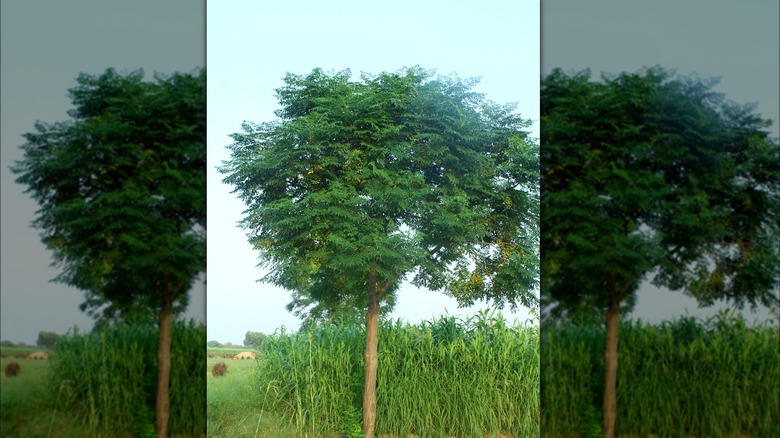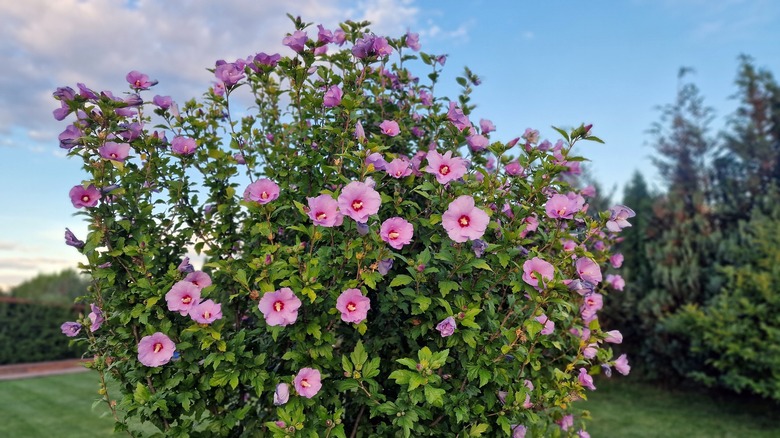Growing These Trees To Attract Hummingbirds Is A Big Mistake
Flashy colors, saber wings, and fancy acrobatic antics — truly, with such moments on the menu, it's no wonder gardeners are eager to weave their own hummingbird gardens. Or, at the very least, pop a tree or two on their land to draw the attention of hummers and turn them into regular visitors. The task isn't difficult, either. Merely look for trees that bloom nectar-rich flowers — even better if they're colored red, pink, or orange. Or, plant ones that are tall and dense enough to serve as cover and torpor grounds for hummers. Unfortunately, not all such flowering trees may be safe for planting.
Certain hummingbird-friendly trees are known to slip free of their cultivated boundaries, displace native vegetation, and wreak havoc on the local ecosystem. Mimosa, horse chestnut, and rose of Sharon are a few such examples, making them inappropriate planting choices from an ecological perspective. Others, like black locust trees, produce exceedingly poisonous fruits or leave the ground a jumbled mess with their shedding. For this reason, you wouldn't want them anywhere near your home, risking your health or feet. With that in mind, here are a few trees you shouldn't grow in your yard to attract hummingbirds.
Mimosa trees are messy and weedy
Anyone keen on attracting ruby-throated hummingbirds to their yard is potentially privy to the chokehold mimosa trees (Albizia julibrissin) have on these tiny jewels. Their silken pink clusters ooze with nectar, serving as delicious spring and summer treats. Ornamentally, they entice growers with their fern-like foliage and copper fruit pods that persist through winter, ensuring multi-season interest.
Yet, you might want to rethink growing a mimosa tree in your yard. While it's nice to have bare tree branches loaded with pods contrasting beautifully against the snowy backdrop, they serve as gateways for ecosystem destruction. Mimosa trees profusely produce seeds that drop out of their pods between September and November, birthing new plants. Worse, the seeds disperse by water or mammals and are capable of germinating even after five years. As a result, mimosa trees have escaped their bounds, outcompeting native plants. That's why they're considered invasive in Alabama, Florida, Georgia, Kentucky, Maryland, Missouri, New Jersey, North Carolina, Pennsylvania, South Carolina, Tennessee, Virginia, and West Virginia. They also reproduce vegetatively, which makes them difficult to weed out without herbicides.
Even beyond the invasive ranges, including the northern areas where they're frost-killed, mimosa trees pose problems. As they're fast growers, mimosa trees have weak limbs that can't withstand winds and sleet, leading to limb breakage and dieback. Their toxic leaf and pod litter demands cleanup, or your pets will get sick. Consider growing eastern redbud trees (Cercis canadensis) in their stead since they're just as hummingbird-friendly.
Chinaberry trees are unsafe because of their toxicity
Although nectar remains the main draw for hummingbirds in most yards, they're just as needy for shelter. After all, all that incessant wing beating takes its toll. That's where Chinaberry trees (Melia azedarach) factor in since their 30-foot-wide rounded canopies provide ample cover. In residential landscapes, they're prized as shade trees that add ornamental beauty with their lilac flowers and fall colors. They're also notable for their unfussy nature, as they adapt to most growth conditions without attracting the ire of pests or falling afoul of diseases.
However, there are myriad Chinaberry tree troubles every gardener should know before planting. For starters, they've been marked as invasive across Alabama, California, Georgia, Maryland, South Carolina, Tennessee, and Virginia. While it's tempting to leave their fruits because they're sought by winter birds, such wildlife service empowers their dispersal. Worse, the sticky seeds are highly toxic to children and your furry friends when consumed. In fact, all plant parts of Chinaberry trees, including their blooms, bark, leaves, and roots, are poisonous since they contain traces of tetranortriterpene and saponin. They also shoot out root suckers that eventually pack into thickets, warranting chemical treatments for removal. To coax hummingbirds into returning to your yard, substitute Chinaberry trees with elderberry (Sambucus nigra ssp. canadensis) or sweet bay magnolia (Magnolia virginiana).
Black locust trees are aggressive spreaders and highly toxic
Another flowering tree that's popular among ruby-throated hummingbirds is the black locust (Robinia pseudoacacia). Its perfumed, wisteria-esque white blooms are chock-full of sweet nectar, feeding the hummers during spring and summer. Gardeners like it for populating tricky site conditions, especially those flanked by black walnut trees. As close cousins to peas, black locust trees also fix nitrogen, making them suitable for impoverished soils.
But, growing black locust trees to attract pollinators is a big mistake. While they're native to southern Appalachian Mountain ranges and certain mid-South areas, black locust trees have showcased colonizing tendencies in the Midwest. Consequently, they're considered invasive in several states, including California, Connecticut, Massachusetts, New Jersey, and Wisconsin. These deciduous trees send across numerous root suckers, rapidly creating clonal groves, as they're fast growers. Not only do these fibrous roots trample upon desirable plants, spoiling the garden bed aesthetic, but they're also hard to pull out. They're prolific self-seeders, creating a huge mess in the yards, though they might not always germinate. Even worse, their seeds, bark, and foliage contain toxic alkaloids, so having them sit on your garden dirt may prove unsafe for curious pets and children. Moreover, black locust trees produce vicious thorns and spines that are only useful for creating security, not shade. Their limbs are prone to breakage under ice or wind. Finally, they may be fatally attacked by leaf borers or leaf miners in certain regions.
Horse chestnut trees are weak-wooded and create thorny seed clutter
Horse chestnut (Aesculus hippocastanum) trees are widely planted for their ornamental and wildlife value. Mid-spring, they bloom gorgeous red-flushed white flowers, luring in hummingbirds and bees. Later, they make way for copper fruits containing horse chestnuts, on which squirrels love to gorge themselves. Other times, their round crowns shade the yard, braving most urban soils, from acidic to alkaline — but that's where their redeeming qualities end.
Horse chestnut trees feature on the Mid-Atlantic Exotic Pest Plant Council list. They're also listed as invasive in Oregon, given their propensity to take over natural areas and disturbed habitats. They're unsafe in areas experiencing high pedestrian traffic because their nuts are encased in spiny burrs that are painful to touch. In fact, they're even hard enough to dent cars, not to mention a looming slip hazard. Moreover, these sentinels create quite a jumble when they shed leaves and twigs. In exposed locations, their frail boughs break away under sleet and ice. They're also high maintenance since they're highly susceptible to pests and diseases. Japanese beetles and leaf blotch disease are the worst offenders, though leaf scorch (in dry sites) and powdery mildew are just as common. Worse, every inch of a horse chestnut tree, from its bark, flowers, foliage, and stems to fruits and seeds, is toxic, often resulting in death on consumption, according to NC State Extension.
Rose of Sharon is considered invasive in some states
Topping out at 12 feet, the rose of Sharon (Hibiscus syriacus) is a small deciduous tree, often massed as a hedge or grown as a specimen in pollinator gardens. Aside from butterflies and bees, it attracts hummingbirds with its nectar-rich, two-toned blooms all summer long for pollination. Its tolerance for wet soils and salt sprays, deer resistance, and fast growth further fuel its popularity.
Unfortunately, the rose of Sharon exhibits intrusive tendencies. When allowed to go to seed (around late summer through fall), it quickly establishes new plants, choking out neighboring vegetation. It has a checkered history of monopolizing native plants in the wild after escaping from gardens. So, the rose of Sharon plantings are highly discouraged or illegal in Georgia, West Virginia, Kentucky, Maryland, and Virginia, where they're labeled invasive. They're also weak-limbed and break easily when exposed to strong winds. In the upper ranges of their adaptive area (zones 5 through 9), they come under attack from Japanese beetles. The alternative is to plant sterile rose of Sharon varieties to attract hummingbirds, such as 'Diana,' 'Minerva,' and 'Helene'.





